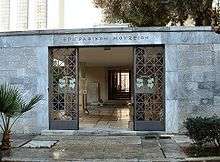Epigraphical Museum
| Επιγραφικό Μουσείο | |
 | |
| Established | 1885 |
|---|---|
| Location | 1 Tositsa Str., Athens, Greece |
| Type | Archaeological museum |
| Public transit access |
|
The Epigraphical Museum (Greek: Επιγραφικόν μουσείον) of Athens, Greece, is unique in Greece and the largest of its kind in the world. Its collection comprises 14,078, mostly Greek, inscriptions, which cover the period from early historical times to the Late Roman period, primarily in Greece. It is situated in the south wing of the National Archaeological Museum of Athens. It comprises an internal and external courtyard (atrium), a lobby, eleven rooms, a large hypostyle Pi-shaped corridor, a gallery, offices, a laboratory for the conservation of inscribed stone monuments and lavatories. Only the courtyards, lobby and four rooms are open to the public, while the rest is reserved for researchers. A full photographic archive of the collection is being assembled for future visitors.
Gallery
Further reading
- Inscriptiones Graecae: Consilio Et Auctoritate Academiae Scientiarium Berolinensis Et Brandenburgensis Editae (Multilingual Edition) (ISBN 311-0-177188)
External links
| Wikimedia Commons has media related to Epigraphical Museum in Athens. |
- Ministry of Culture and Tourism
- Michael Scott. "Delphi: The Bellybutton of the Ancient World". 38:03 minutes in. BBC 4. Retrieved 23 Nov 201. Check date values in:
|access-date=(help); Missing or empty|series=(help)
Coordinates: 37°59′18.8″N 23°43′56.3″E / 37.988556°N 23.732306°E